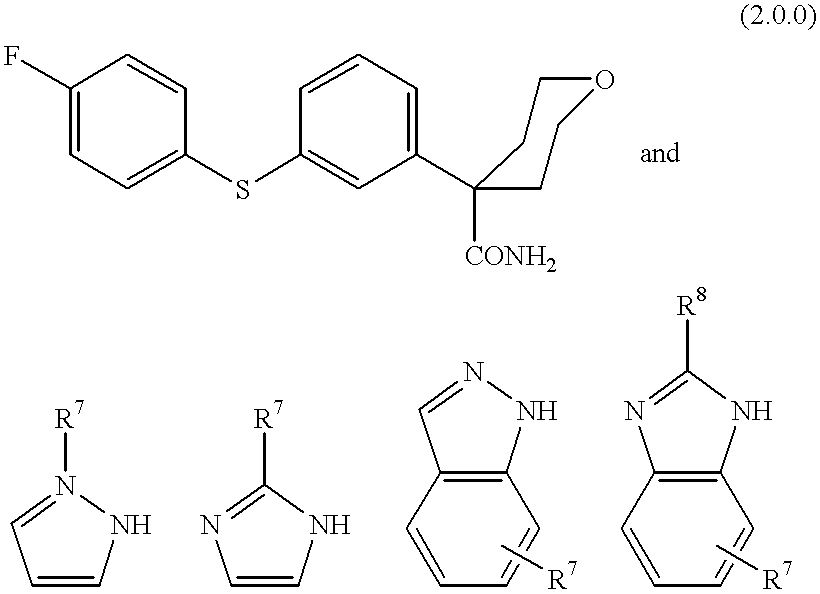Process for making 5-lipoxygenase inhibitors having varied heterocyclic ring systems
a technology of heterocyclic ring system and process, applied in the direction of organic chemistry, etc., can solve the problems of low yield and products requiring further purification
- Summary
- Abstract
- Description
- Claims
- Application Information
AI Technical Summary
Problems solved by technology
Method used
Image
Examples
example 1
Synthesis of tetrahydro-4-(3-bromophenyl)-2H-pyran-4-nitrile ##STR113##
3-Bromophenylacetonitrile (20.0 g, 102 mmole, 1 eq.), commercially available from Aldrich Chemical Co., Milwaukee, Wis., tetrahydrofuran (120 ml), 40% aqueous sodium hydroxide solution (180 ml, mmole, eq.), tetrabutylammonium hydrogensulfate (3.46 g, mmole, 0.1 eq.) were stirred in a reaction flask set for boiling at reflux. Thereafter, 2,2'-dichlorodiethylether (13.75 ml, 117.3 mmole, 0.1 eq.) was added with stirring at room temperature, 20-25.degree. C. The resultant reaction mixture was boiled at reflux for 5-8 h at approximately 64.degree. C. The reaction mixture was cooled to ambient temperature and ethyl acetate (154 ml) was added. The lower aqueous layer was separated and the organic layer evaporated down into a red oil. Iso-propanol (100 ml) and water (10 ml) were added to the oil and stirred at 0.degree. C. overnight to yield a crystal slurry. The crystal slurry was vacuum filtered, washed with isopropan...
example 2
Synthesis of tetrahydro-4-[3-(4-fluorophenyl)-thio]-phenyl-2H-pyran-4-carboxamide ##STR114##
Propan-2-ol (120 ml); tetrahydro-4-(3-bromophenyl)-2H-pyran-4-nitrile (20.0 g, 75.15 mmole, 1 eq.); potassium hydroxide (9.76 g, 150.30 mmole, 2 eq.); (triphenylphosphine)palladium(0) (174 mg, 0.150 mmole, 0.002 eq.); (S)-(--)-2,2'-bis(diphenylphosphino)-1,1'-binaphthyl [(S)-BINAP, 187 mg, 0.301 mmole, 0.004 eq.]; and 4-fluorothiophenol (8.0 ml, 75.15 mmole, 1 eq.) were added to a reaction flask set for boiling at reflux under a nitrogen atmosphere. The resultant reaction mixture was boiled at reflux for 20-24 h at approximately 82.degree. C. The reaction mixture was cooled to ambient temperature, 20-25.degree. C., and water (120 ml) was added to obtain a slurry which was stirred for an additional 2 hours. The crude product was isolated by filtration and the wet cake was transferred to a flask to which acetic acid (160 ml, 8 vol) was added. The solution was heated to 100.degree. C. with stirr...
example 3
Synthesis of tetrahydro-4-[3-(4-fluorophenyl)-thio]-phenyl-2H-pyran-4carboxamide ##STR115##
Propan-2-ol (150 ml, 6 vol.); tetrahydro-4-(3-bromophenyl)-2H-pyran-4-nitrile (24.98 g, 93.9 mmole, 1 eq.); potassium hydroxide (12.12 g, 188 mmole, 2 eq.); water (1.93 g, 188 mmole, 2 eq.); tetrakis (triphenylphosphine)palladium(0) (1.085 g, 0.939 mmole, 0.01 eq.); triphenylphosphine (TPP: 0.493 g, 1.88 mmole, 0.02 eq.); and 4-fluorothiophenol (12.03 g, 93.9 mmole, 1 eq.) were added to a reaction flask set for boiling at reflux under a nitrogen atmosphere. The resultant reaction mixture was boiled at reflux for 20-24 h at approximately 84.degree. C. The reaction mixture was cooled to 70.degree. C., and water (150 ml) was added, after which the reaction mixture was further cooled to room temperature, granulated for 1 hour and filtered. The resulting tan filter cake was washed with an iso-propanol / water solution (60 ml each). The filter cake was then transferred to a reaction flask to which ace...
PUM
 Login to View More
Login to View More Abstract
Description
Claims
Application Information
 Login to View More
Login to View More - R&D
- Intellectual Property
- Life Sciences
- Materials
- Tech Scout
- Unparalleled Data Quality
- Higher Quality Content
- 60% Fewer Hallucinations
Browse by: Latest US Patents, China's latest patents, Technical Efficacy Thesaurus, Application Domain, Technology Topic, Popular Technical Reports.
© 2025 PatSnap. All rights reserved.Legal|Privacy policy|Modern Slavery Act Transparency Statement|Sitemap|About US| Contact US: help@patsnap.com



